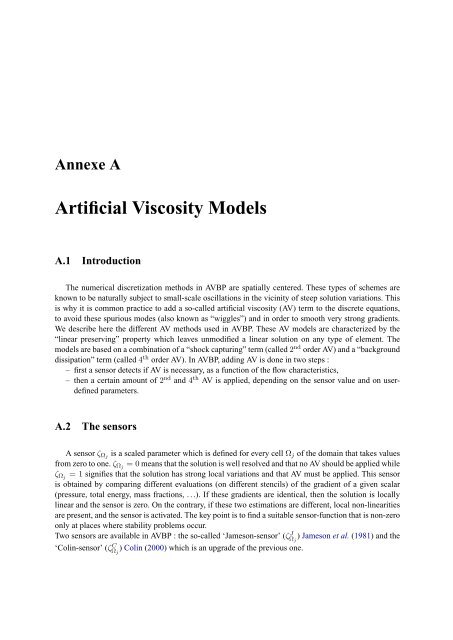these simulation numerique et modelisation de l'ecoulement autour ...
these simulation numerique et modelisation de l'ecoulement autour ...
these simulation numerique et modelisation de l'ecoulement autour ...
Create successful ePaper yourself
Turn your PDF publications into a flip-book with our unique Google optimized e-Paper software.
Annexe A<br />
Artificial Viscosity Mo<strong>de</strong>ls<br />
A.1 Introduction<br />
The numerical discr<strong>et</strong>ization m<strong>et</strong>hods in AVBP are spatially centered. These types of schemes are<br />
known to be naturally subject to small-scale oscillations in the vicinity of steep solution variations. This<br />
is why it is common practice to add a so-called artificial viscosity (AV) term to the discr<strong>et</strong>e equations,<br />
to avoid <strong>these</strong> spurious mo<strong>de</strong>s (also known as “wiggles”) and in or<strong>de</strong>r to smooth very strong gradients.<br />
We <strong>de</strong>scribe here the different AV m<strong>et</strong>hods used in AVBP. These AV mo<strong>de</strong>ls are characterized by the<br />
“linear preserving” property which leaves unmodified a linear solution on any type of element. The<br />
mo<strong>de</strong>ls are based on a combination of a “shock capturing” term (called 2 nd or<strong>de</strong>r AV) and a “background<br />
dissipation” term (called 4 th or<strong>de</strong>r AV). In AVBP, adding AV is done in two steps :<br />
– first a sensor d<strong>et</strong>ects if AV is necessary, as a function of the flow characteristics,<br />
– then a certain amount of 2 nd and 4 th AV is applied, <strong>de</strong>pending on the sensor value and on user<strong>de</strong>fined<br />
param<strong>et</strong>ers.<br />
A.2 The sensors<br />
A sensor ζ Ωj is a scaled param<strong>et</strong>er which is <strong>de</strong>fined for every cell Ω j of the domain that takes values<br />
from zero to one. ζ Ωj = 0 means that the solution is well resolved and that no AV should be applied while<br />
ζ Ωj = 1 signifies that the solution has strong local variations and that AV must be applied. This sensor<br />
is obtained by comparing different evaluations (on different stencils) of the gradient of a given scalar<br />
(pressure, total energy, mass fractions, . . .). If <strong>these</strong> gradients are i<strong>de</strong>ntical, then the solution is locally<br />
linear and the sensor is zero. On the contrary, if <strong>these</strong> two estimations are different, local non-linearities<br />
are present, and the sensor is activated. The key point is to find a suitable sensor-function that is non-zero<br />
only at places where stability problems occur.<br />
Two sensors are available in AVBP : the so-called ‘Jameson-sensor’ (ζΩ J j<br />
) Jameson <strong>et</strong> al. (1981) and the<br />
‘Colin-sensor’ (ζ C Ω j<br />
) Colin (2000) which is an upgra<strong>de</strong> of the previous one.

















